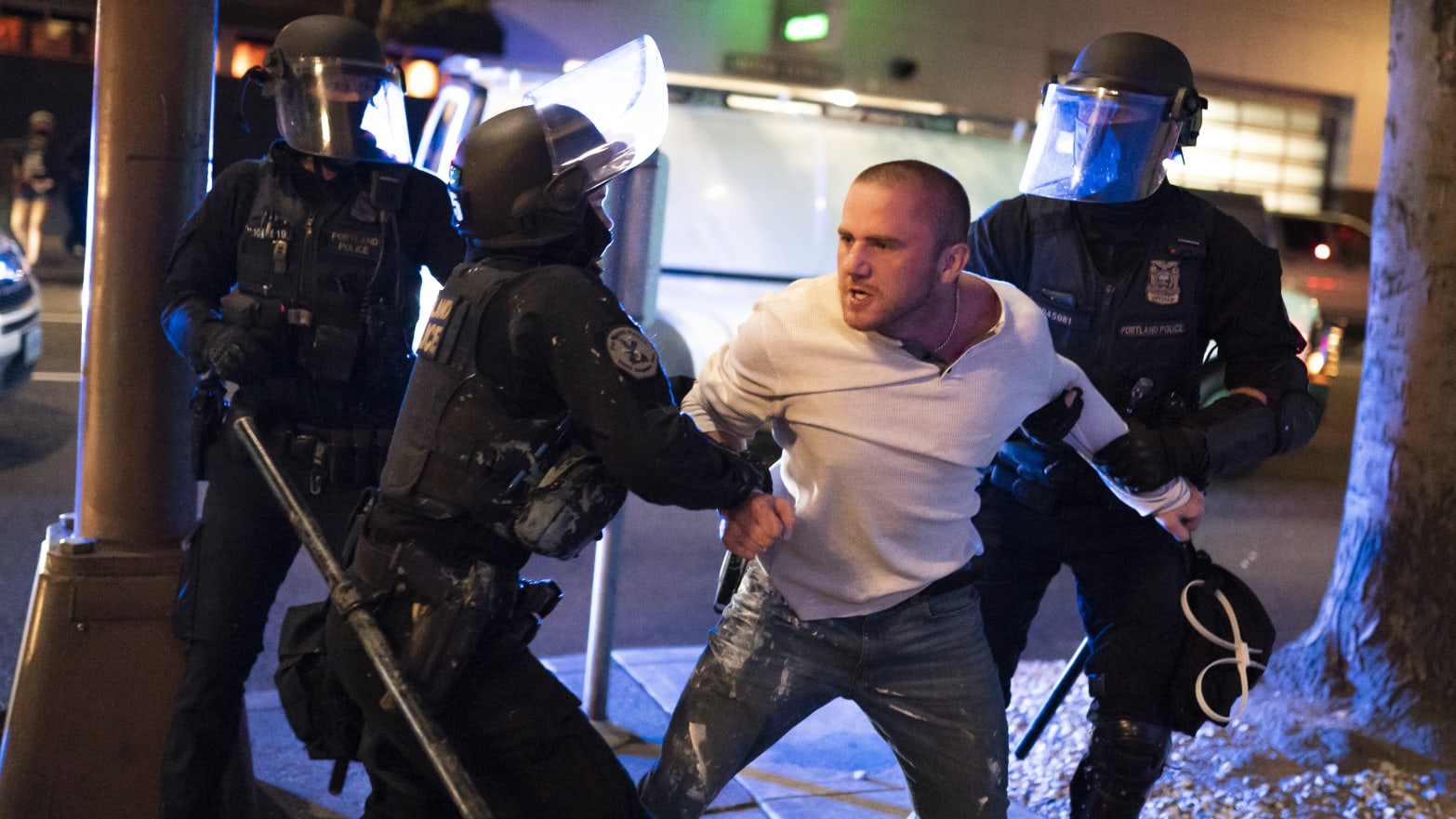Less than 24 hours after a man was fatally shot in downtown Portland, Oregon’s governor offered what looked like a way forward: a six-point, “unified law enforcement plan” enlisting the help of local, state, and federal officers to “protect free speech and bring violence and arson to an end in Portland.”
But with Portland now close to 100 consecutive nights of protests, most of which have resulted in violent clashes between protesters and law enforcement, the plan doesn’t have much in terms of substance. Local jurisdictions are declining to send in backup. State troopers are deputizing their own, effectively circumventing the local district attorney’s office. And the federal government is, once again, threatening to send in troops.
“We have a schoolyard beef going on and people are acting like adolescents,” said Mike German, retired FBI agent and fellow at the Brennan Center for Justice.
“Rather than taking responsibility for the errors they’ve made thus far and trying to actually resolve the issues the protesters are trying to raise, we instead see these agencies look to gain some political edge.”
Portland has been mired in nightly protests since the end of May, when rage over the killing of George Floyd in Minneapolis police custody led people to take to the streets nationwide. Most nights have seen law enforcement officers rushing protesters with fists, batons, and crowd control munitions including tear gas, pepper balls, and smoke bombs, often in response to a small number of black-clad demonstrators lighting fires, breaking windows, vandalizing buildings, and throwing projectiles at officers, such as rocks, water bottles, and paint.
As of this writing, local and state police officers have made close to 800 arrests related to the protests, according to Oregon State Police. Of those 800, close to 700 arrests are claimed by PPB, according to the bureau’s own numbers.
The overwhelming majority of charges are “interfering with a peace officer,” “disorderly conduct,” and “resisting arrest.” Cops have arrested protesters for alleged crimes such as setting fires and shining lasers in officers’ eyes. Often, however, officers arrest protesters for talking back to them and failing to move out of their way.
Multnomah County District Attorney Mike Schmidt announced in mid-August a policy against prosecuting protest-related cases that didn’t include the use of force against someone else, deliberate property damage, or theft. “As prosecutors, we acknowledge the depth of emotion that motivates these demonstrations and support those who are civically engaged through peaceful protesting,” Schmidt wrote in a statement at the time.
Oregon State Police, sent to Portland at the beginning of August to take over for federal law enforcement officers defending the Mark O. Hatfield United States Courthouse, withdrew in a huff. “At this time, we are inclined to move those resources back to counties where prosecution of criminal conduct is still a priority,” said OSP’s Timothy Fox.
Since then, Portland Police have been mostly going it alone, with a backlog of cases piling up at the County DA. When asked about a total number of prosecutorial cases, the Multnomah County DA’s Office did not offer any figures. “We still don’t have a final number of the cases we will be prosecuting because we continue to review new cases each day, many older cases remain under follow-up investigation, and because each new case is still being independently reviewed by our team of 10 attorneys.”
Last weekend, the violence turned deadly. After a miles-long caravan of Trump supporters drove through downtown Portland on Saturday evening, a man associated with the far-right group Patriot Prayer was fatally shot in the chest. “For the last several years, and escalating in recent months, President Trump has encouraged division and stoked violence,” Oregon Gov. Kate Brown said the following day. “It happened in Charlottesville. It happened in Kenosha. And now, unfortunately, it is happening in Portland, Oregon.”
It was in the aftermath of that shooting that Brown’s office unveiled the “unified law enforcement plan to protect free speech and bring violence and arson to an end in Portland.”
“With months of nightly protests stretching the Portland Police Bureau’s resources thin, additional local and state personnel, as well as federal resources, will give the Police Bureau the investigative capacity to arrest and charge those individuals who have engaged in violent or destructive acts and endangered public safety,” her statement read.
The plan instructed the Multnomah County DA’s Office to continue prosecuting serious criminal offenses, “including arson and physical violence,” related to the protests. It requested that Oregon State Police send backup officers to support the PPB and asked the U.S. Attorney’s Office and the Federal Bureau of Investigation to commit additional resources for investigations. Nearby jurisdictions were also asked for additional personnel and resources to support PPB.
But local jurisdictions refused. The City of Gresham’s police chief released a statement the following day: “Governor Brown released her plan without consultation with the listed agencies. At this time, Gresham Police Department will not be assisting our colleagues at Portland Police Bureau.”
Both sheriffs’ offices for Washington County and Clackamas County took a more strongly worded approach.
“At this time, I do not plan to send deputies to work directly in Portland,” wrote Washington County Sheriff Pat Garrett in a statement the same day.
“PPB is a terrific partner and I am very sympathetic to what they are enduring. However, the lack of political support for public safety, the uncertain legal landscape, the current volatility combined with intense scrutiny on use of force presents an unacceptable risk if deputies were deployed directly.”
Clackamas County Sheriff Craig Roberts took direct aim at the Multnomah County DA’s Office in a statement the same day.
“Increasing law enforcement resources in Portland will not solve the nightly violence and now, murder. The only way to make Portland safe again is to support a policy that holds offenders accountable for their destruction and violence.”
Oregon State Police say they are ready to help local law enforcement, as they did in mid-August after federal troops withdrew from the protest area. Now, a group of roughly 50 state troopers, as part of OSP’s Mobile Response Team, are in Portland to assist local law enforcement.
Only this time, the majority of state troopers deployed have been deputized, which means they have the dual authority of state and federal law enforcement. This effectively bypasses the local district attorney’s office by allowing the U.S. Attorney’s Office, instead, to prosecute offenders.
“OSP is not criticizing any officials and we respect the authority of the District Attorney, but to meet the Governor’s charge of bringing violence to an end we will use all lawful methods at our disposal,” Fox said in an email to The Daily Beast.
The governor’s office said state troopers were deputized over the summer to allow them to work more effectively with federal law enforcement, according to a statement from Charles Boyle, a spokesman for Governor Brown’s office.
Also critical of the local district attorney is the federal government. In a letter to Portland Mayor Ted Wheeler on Monday, Acting Department of Homeland Security Secretary Chad Wolf criticized the city’s “lack of action” in tamping down on protest-related violence, and threatened to, once again, send in federal troops.
As part of President Trump’s July 4 executive order to protect federal monuments, troops from the Department of Homeland Security, Federal Protective Service, and Immigration and Customs Enforcement began confronting protesters outside the federal courthouse. That led to consecutive nights of arrests, injuries, and wide sections of downtown Portland being coated in tear gas.
“For whatever reason, police departments have adopted these escalating force models that have created this violence,” explained German, whose own civil rights work revolves around national law enforcement issues.
German points to a 2015 article by the St. Louis University School of Law that envisions a new model of protest policing that includes police officers facilitating protests and showing support toward crowd members as de-escalation tactics.
“I’d be interested to see how this kind of policing model could ever bring an end to this,” he said.

